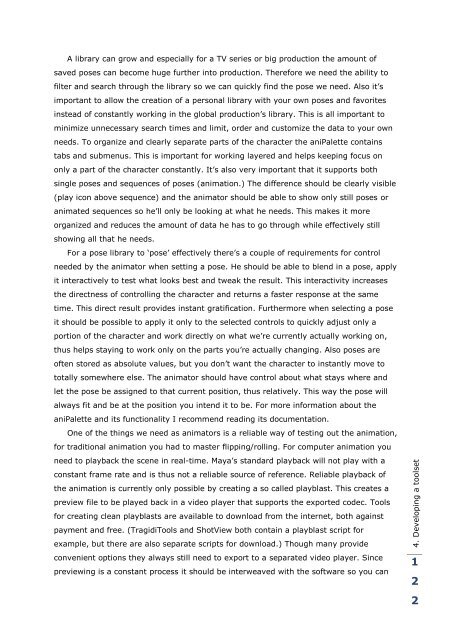Release. Pressure. Animate.
Release. Pressure. Animate.
Release. Pressure. Animate.
Create successful ePaper yourself
Turn your PDF publications into a flip-book with our unique Google optimized e-Paper software.
A library can grow and especially for a TV series or big production the amount of<br />
saved poses can become huge further into production. Therefore we need the ability to<br />
filter and search through the library so we can quickly find the pose we need. Also it‟s<br />
important to allow the creation of a personal library with your own poses and favorites<br />
instead of constantly working in the global production‟s library. This is all important to<br />
minimize unnecessary search times and limit, order and customize the data to your own<br />
needs. To organize and clearly separate parts of the character the aniPalette contains<br />
tabs and submenus. This is important for working layered and helps keeping focus on<br />
only a part of the character constantly. It‟s also very important that it supports both<br />
single poses and sequences of poses (animation.) The difference should be clearly visible<br />
(play icon above sequence) and the animator should be able to show only still poses or<br />
animated sequences so he‟ll only be looking at what he needs. This makes it more<br />
organized and reduces the amount of data he has to go through while effectively still<br />
showing all that he needs.<br />
For a pose library to „pose‟ effectively there‟s a couple of requirements for control<br />
needed by the animator when setting a pose. He should be able to blend in a pose, apply<br />
it interactively to test what looks best and tweak the result. This interactivity increases<br />
the directness of controlling the character and returns a faster response at the same<br />
time. This direct result provides instant gratification. Furthermore when selecting a pose<br />
it should be possible to apply it only to the selected controls to quickly adjust only a<br />
portion of the character and work directly on what we‟re currently actually working on,<br />
thus helps staying to work only on the parts you‟re actually changing. Also poses are<br />
often stored as absolute values, but you don‟t want the character to instantly move to<br />
totally somewhere else. The animator should have control about what stays where and<br />
let the pose be assigned to that current position, thus relatively. This way the pose will<br />
always fit and be at the position you intend it to be. For more information about the<br />
aniPalette and its functionality I recommend reading its documentation.<br />
One of the things we need as animators is a reliable way of testing out the animation,<br />
for traditional animation you had to master flipping/rolling. For computer animation you<br />
need to playback the scene in real-time. Maya‟s standard playback will not play with a<br />
constant frame rate and is thus not a reliable source of reference. Reliable playback of<br />
the animation is currently only possible by creating a so called playblast. This creates a<br />
preview file to be played back in a video player that supports the exported codec. Tools<br />
for creating clean playblasts are available to download from the internet, both against<br />
payment and free. (TragidiTools and ShotView both contain a playblast script for<br />
example, but there are also separate scripts for download.) Though many provide<br />
convenient options they always still need to export to a separated video player. Since<br />
previewing is a constant process it should be interweaved with the software so you can<br />
4. Developing a toolset<br />
1<br />
2<br />
2


